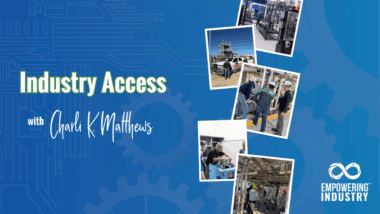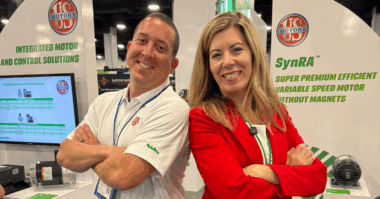Customer centric solutions are the key for improving productivity and pump life
More than 60,000 people attended the 2105 AHR Expo in Chicago Jan 26-28…and if they are like me…they left Chicago enriched by the experience.
The meeting attracted attendees and companies from around the world at this one of one kind event, with the pump world making a strong statement about the direction of the industry.
As we walked the aisles, talked with company representatives and attendees, energy efficiency and big data were phrases we heard often. It’s obvious to me that pump industry is listening to the changing market needs for more energy efficient pumps in response to higher energy costs and tighter regulations. We are also starting to see more and more companies embracing the power of data to manage equipment more efficiently.
Here are just a few highlights from the meeting:
For Armstrong Fluid Technology, the company is investing further in its relationships with its customers. In the last few years, the company has transitioned away from a transactional business model to one of solving problems for its customers. Listen first…then talk.
In the last several years, the company has invested in developing solutions that lower installation costs, life-cycle costs, and operating costs with durable and innovative products and services.
Bernard Dietz, Director of Brand Development, told me that the company spends time with its customers to ensure the site, application and equipment needs are aligned prior to installation. They’ve found that starting a relationship with a mutual understanding has led to stronger customer relationships. Last year, Armstrong began explaining its strategy to its customers and the investment is already experiencing big returns.
Armstrong is another company that is quickly embracing real-time data on pump and engine operations, and the company demonstrated its capabilities with a system based in Hong Kong at the meeting. Data will be a powerful tool in proactively managing part wear and preventive maintenance strategies.
Finally, to prove customer-centric focus, the company now offers financial performance guarantees. If mutually agreed upon performance guarantees are not met in the first year, Armstrong will compensate the customer up to $100,000.
I love this customer-first strategy, and it’s something we all can learn from.
Next up was Nidec Motor Corporation, which unveiled a brushless permanent magnet (BPM) electronically commutated (EC) pump motor with an integrated variable frequency drive and user interface at the meeting.
Scott Durfee Director of Product Management at Nidec, shared that the HVAC industry embraced the technology several years ago and is featured in nearly all high-efficiency furnaces these days. And, now it’s migrating to motors.
The new technology can be found on the company’s PerfectSpeed® NEMA® 48 pump motor is an energy saving product which is easy to install and operate. It has been designed specifically to drive booster and hydronic pumps. Both the motor and drive are manufactured by NMC and are optimized to function together for highly efficient and worry-free operation. The on-board drive regulates pump performance so that maximum efficiency is achieved during normal and peak flow operation. The drive eliminates the need for mechanical components like hydraulic control valves, pump speed controls, and large control panels.
“The PerfectSpeed NEMA 48 pump motor has been engineered to make installation easy. Our integrated motor and drive eliminates the need for separate, time consuming drive programming,” said Durfee, “We’ve used our motor/drive technology and expertise to eliminate the complexity of an installation. This is truly a product you can confidently install, configure, start, and walk away.”
At Danfoss, the company emphasized its deep roots of innovation. For more than 80 years, Danfoss has focused on engineering innovative, reliable technologies that reduce energy use and environmental impact, and, today, the company remains committed to product development and partnerships that enable its customers to meet the challenges and standards of tomorrow.
In fact, Danfoss was been recognized by a panel of ASHRAE members with a 2015 AHR Expo Innovation Award, green building category, for its Turbocor VTT series of oil-free, variable speed, magnetic bearing centrifugal compressors. The Danfoss compressor, intended for commercial air conditioning or process cooling applications that require a high efficiency solution, qualified to compete for the top award by taking top honors in the Green Building category. Congratulations to Danfoss!
For the AHR, the company highlighted its integrated solutions for the market. Frank and Joe shared, and I agree, that the industry is needs more partners and not just suppliers. As a result, you will see Danfoss continue to push its products in new areas like noise reduction, different configurations to meet space requirements, and a variety of offerings for nearly all applications, in a variety of industries.
For example, Danfoss introduced a vertical bypass system that is mounted on the side specifically for the HVAC market to address limited horizontal space. The new design can be stacked to take advantage of limited space. Great innovation based on customers needs!
Bill Beard, Director of Sales at Hartell, shared insight about the company’s strategy to penetrate the HVAC market with a new pump system that is vital, yet relatively hidden from eyes in commercial buildings. Working with the National Fire Protection Agency, the company created a new pump system that meets its rigorous codes in commercial buildings.
During normal operation of central air conditioning units, gas condensing furnaces, humidifiers, and de-humidifiers, condensate is created at varying rates, which are proportional to the size and the number of units used in any application. For example, a large hotel may have four HVAC units on each floor, with each one producing condensate every minute of operation. During peak hours of operation, the units can produce several gallons of condensate an hour. As we know, condensate in and on metal ductwork over time is not good.
Whenever gravity drainage is not practical, the condensate drain lines are routed into the inlet ports of the condensate pump. These pumps are, typically, equipped to connect with 3/8″ ID flexible vinyl tubing. The pump directs the wastewater to the main sewage drain line, floor drain, French drain or in some cases, a laundry or utility sink.
With these pumps, performance is paramount, because they are not easy to access after installation. Noise reduction is also important factor with these pump systems.
Hartell condensate pumps are an ideal fit as wastewater drain pumps for a wide variety of appliances such as humidifiers, icemakers, beverage dispensers, drinking fountains, water coolers and dehumidifiers.
At Fuji Electric, NE Sales Manager Brian McCloskey, highlighted the company’s market centric strategy with several new products and offerings.
The company has been assessing the market and has developed products for the HVAC industry that feature narrow designs and operation data to track operational efficiency.
To help simplify installation and pump alignment between motor and drive, the company’s drives feature embedded preset functions. Basically, you can program your drive with a few simple steps. Great functionality and simplicity operators have asked for.
At Schneider Electric, the company featured its remote sensing capabilities for the Industrial Internet. Jack Creamer, Market Segment Manager with Schneider, showed me how customers will have real-time access to information about energy consumption, maintenance, alarms and pump status.
With the majority of pumps in remote, and sometimes odd, locations that are often hard to reach, this could be a huge factor in equipment specification.
Schneider also incorporated QR scanning technology onto its products that greatly simplify the ability to capture and read data immediately. Operators with a Smartphone can install a QR code application, scan the equipment and then enter a password to access data. While QR codes have been around for a few years, it’s a great example of simplifying the ability to capture critical operating data in seconds.
The company is continuing to link its products into integrated solutions that merge the mechanical and electrical world. Jack pointed out the 40% of a pumps cost of ownership is energy and 35% maintenance so even minor improvements in either of those two categories can significantly lower cost of ownership.
With remote data access, operators can better manage wear and replacement strategies on bearings and impellers.
And over at The Metraflex Company, Zeke Bochenek, VP of Sales, demonstrated the company’s new Low-Pressure Drop LPD Y-Strainer.
Zeke told me that the “company completely re-engineered with a screen 50-60% larger than the industry average, more holes and a larger surface area, our new LPD Y-Strainer turns 100 years of strainer design on its Net Positive Suction Head (NPSH).
Compared to traditional strainers, the new LPD Y-Strainer has no bridge wall, enabling fluid to flow straight and smooth at a lower velocity and with less turbulence, minimizing pressure drop. That means the pump can perform more efficiently, saving hundreds of dollars in energy costs each year. Basically, it will move more water with less energy.
What’s more, the larger surface area and greater number of holes on the strainer’s means it takes significantly longer for a screen to clog, reducing unnecessary maintenance and downtime. Sized from 2-1/2 to 12”, the new LPD Y-Strainer is available in 125# cast iron.
We hope you had a great 2105 event!
If you haven’t see our 2014 coverage, it was also a great year for innovation! See below.




